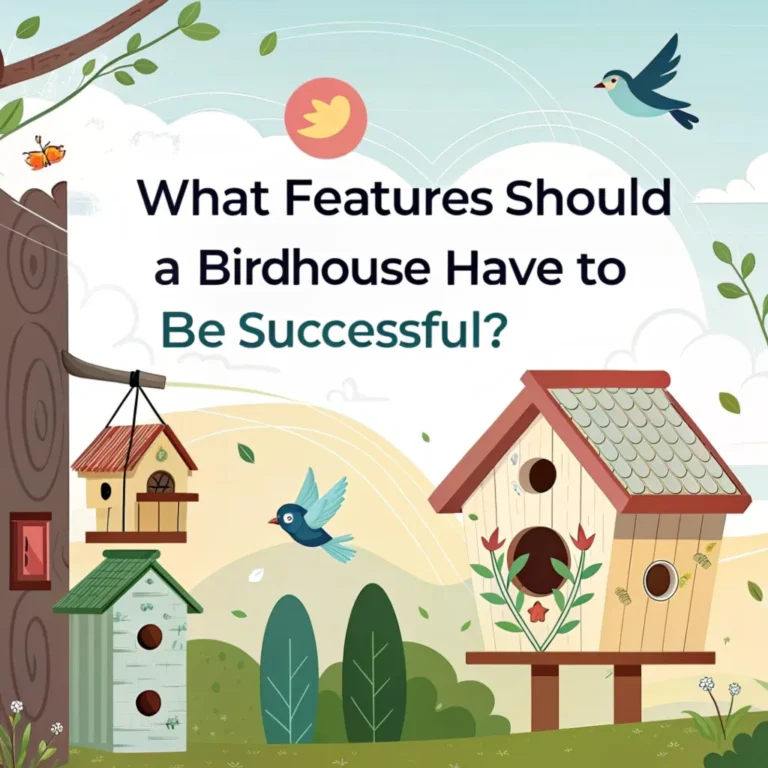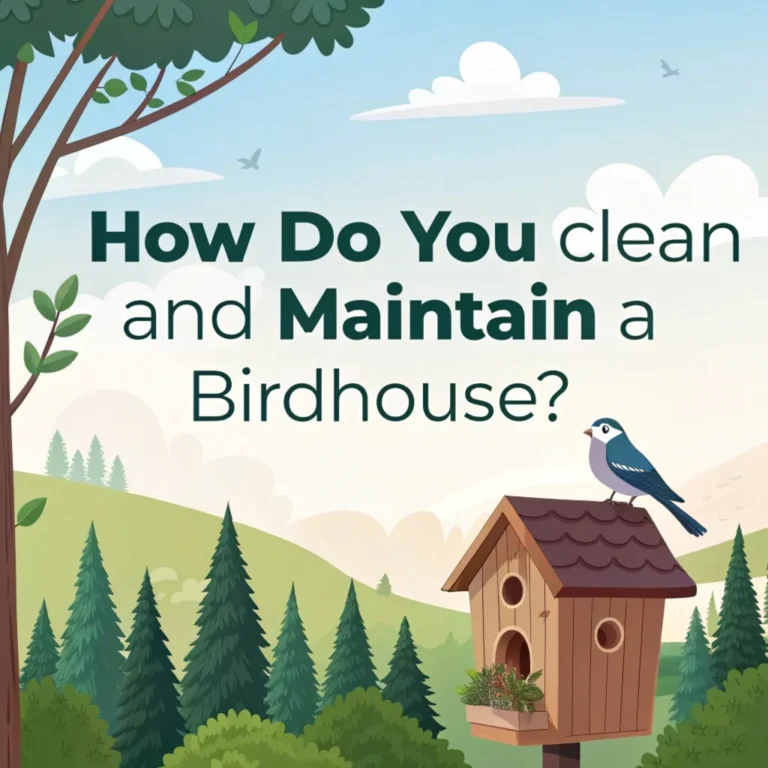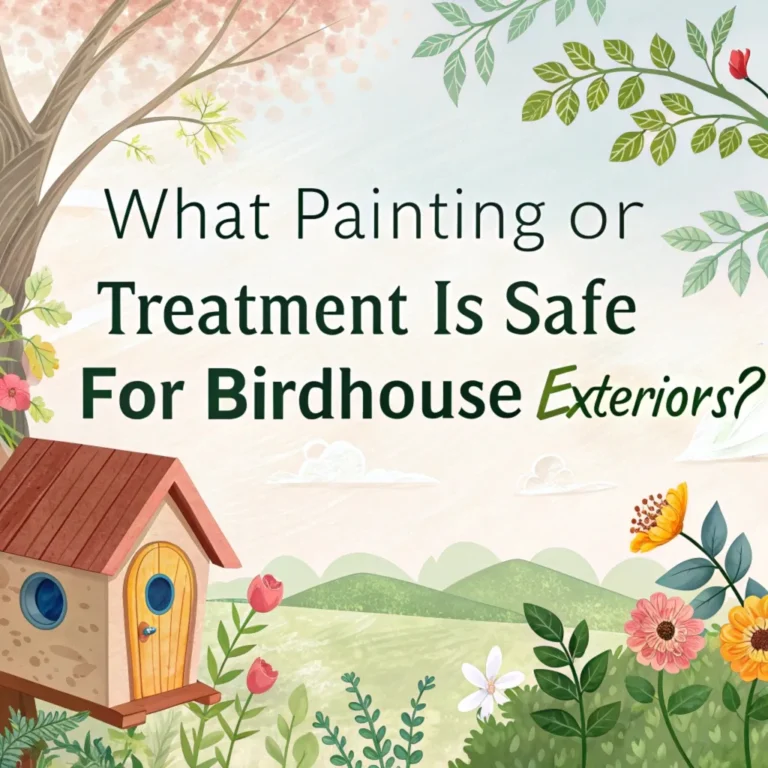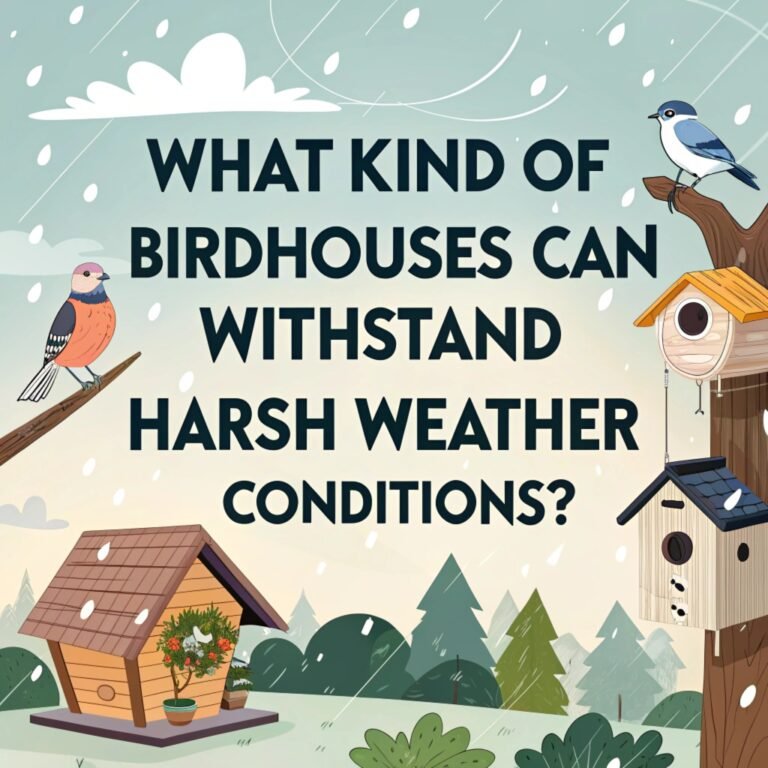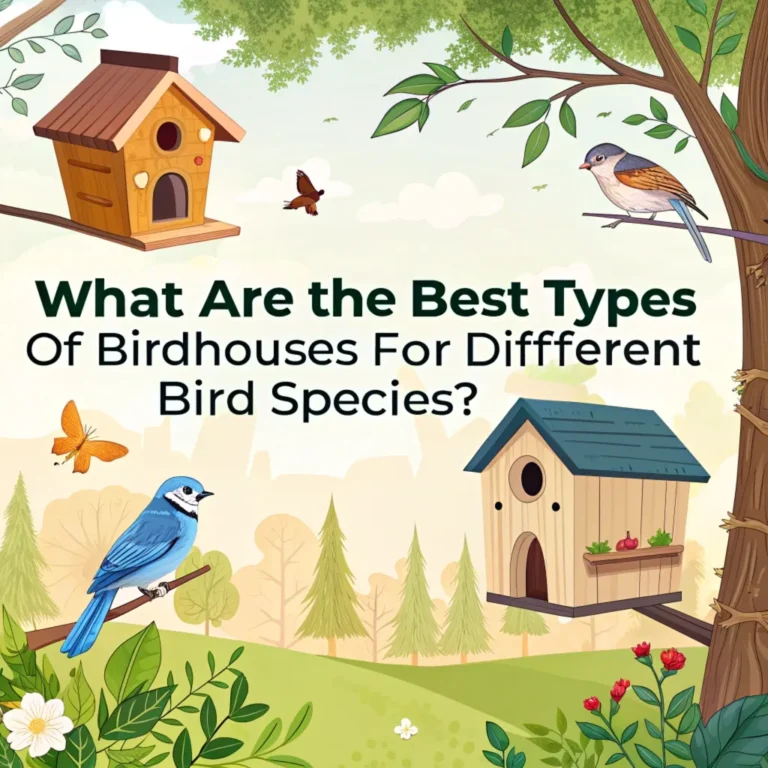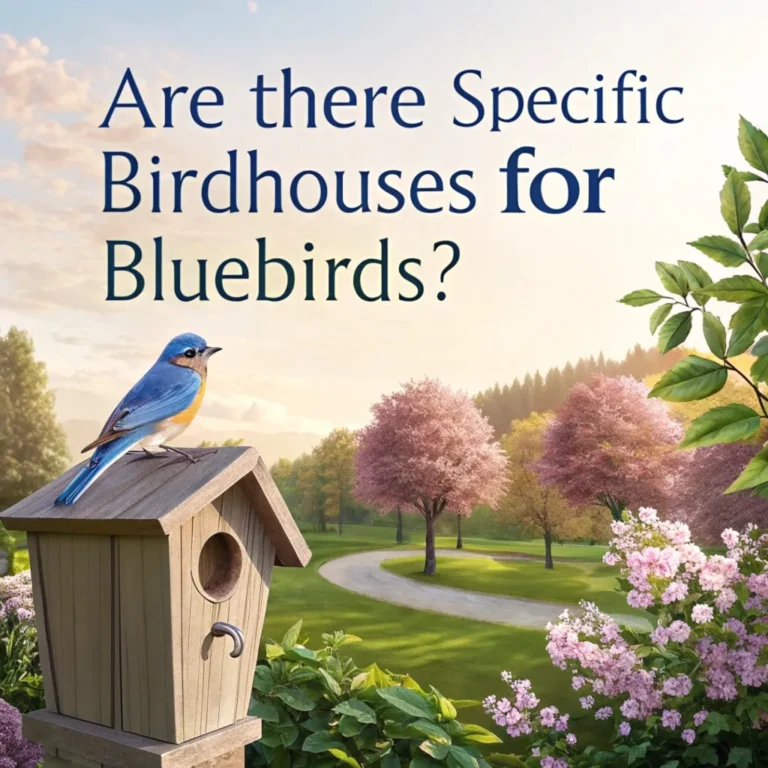How Can Birdhouses Enhance Your Garden’s Ecosystem? Tips and Benefits
Birdhouses offer a simple yet powerful way to enhance your garden’s ecosystem. These structures provide more than just shelter for birds; they create a hub of ecological activity that benefits your entire outdoor space.
By installing birdhouses, you invite a range of positive effects that ripple through your garden, from natural pest control to improved pollination.
This article explores the many ways birdhouses can transform your garden into a thriving, balanced ecosystem.
We’ll look at how these simple structures support biodiversity, contribute to soil health, and even provide stress relief for gardeners.

Key Takeaways:
- Shelter: Birdhouses provide safe nesting sites for cavity-nesting birds
- Pest Control: Birds eat insects, reducing the need for chemical pesticides
- Pollination: Many bird species help pollinate flowers and plants
- Seed Dispersal: Birds spread seeds, promoting plant diversity
- Soil Health: Bird droppings act as natural fertilizer
- Biodiversity: Birdhouses support local bird populations
- Aesthetic Value: Birdhouses add visual interest to gardens
- Educational Opportunities: Observe bird behavior up close
- Stress Relief: Birdwatching can have calming effects
- Conservation: Birdhouses support bird species facing habitat loss
- Weed Control: Some birds eat weed seeds, reducing garden maintenance
- Natural Balance: Birds contribute to overall ecosystem health
- Sustainable Gardening: Birdhouses promote eco-friendly practices
- Wildlife Attraction: Birdhouses bring nature closer to home
Safe Haven for Birds
Birdhouses create essential nesting sites for cavity-nesting birds. These structures offer protection from predators and harsh weather conditions. As natural nesting spots become scarce due to urbanization and deforestation, birdhouses provide a crucial alternative for many bird species.
The design of birdhouses plays a vital role in their effectiveness. Different bird species have specific requirements for entrance hole size, interior dimensions, and overall structure.
By offering a variety of birdhouse styles, you can attract a diverse range of birds to your garden. This diversity not only enhances the ecosystem but also provides a fascinating display of avian behavior for observers.
Proper placement of birdhouses is crucial for their success. Factors such as height, direction, and proximity to food and water sources all influence whether birds will choose to nest in the houses you provide.
By considering these elements, you can create an ideal environment that encourages birds to make your garden their home, fostering a thriving bird population that contributes to the overall health of your garden ecosystem.
Natural Pest Control
Birds act as efficient pest controllers in gardens. Many species feed on insects that can damage plants. By attracting birds with birdhouses, you reduce the need for chemical pesticides. This natural approach to pest management promotes a healthier garden ecosystem.
The pest control benefits of birds extend beyond just insect management. Many bird species also feed on rodents and other small animals that can cause damage to gardens.
By encouraging a diverse bird population through the use of birdhouses, you create a natural defense system against a wide range of potential garden pests. This multi-faceted approach to pest control helps maintain a balanced ecosystem without relying on harmful chemicals.
Seasonal variations in bird activity can impact pest control effectiveness. During nesting season, birds consume larger quantities of insects to feed their young, providing enhanced pest control benefits.
By maintaining birdhouses year-round, you ensure a consistent bird presence in your garden, offering ongoing natural pest management. This continuous protection helps keep pest populations in check throughout the changing seasons.
Pollination Support

Some bird species, particularly those that feed on nectar, play a role in pollination. By providing birdhouses, you encourage these pollinators to visit your garden regularly. This increased bird activity can lead to better pollination of flowers and fruit trees.
The pollination process carried out by birds differs from that of insects. Birds tend to visit flowers with specific characteristics, such as tubular shapes or bright colors, especially red.
By including plants that attract bird pollinators in your garden, you can enhance the overall pollination effectiveness.
This bird-friendly planting strategy, combined with the presence of birdhouses, creates a symbiotic relationship that benefits both the birds and your garden’s plant life.
Hummingbirds are particularly effective pollinators among bird species. While they may not use traditional birdhouses, providing specialized hummingbird houses or feeders can encourage their presence in your garden.
These tiny birds play a crucial role in pollinating a wide variety of plants, including many that are not easily pollinated by insects. By creating a welcoming environment for hummingbirds, you can significantly boost the pollination potential of your garden ecosystem.
Seed Dispersal
Birds contribute to plant diversity through seed dispersal. As they move around your garden and beyond, birds spread seeds through their droppings. This natural process helps maintain and expand plant populations in your local area.
The effectiveness of seed dispersal by birds depends on various factors, including the bird species, the types of seeds they consume, and their movement patterns. Some birds have specialized digestive systems that enhance seed germination after passing through their bodies.
By providing birdhouses and creating a bird-friendly environment, you encourage a diverse range of bird species to visit your garden, each contributing to seed dispersal in its unique way.
Long-distance seed dispersal is another significant benefit of attracting birds to your garden. Birds can carry seeds over considerable distances, helping to introduce new plant species to your area and promoting genetic diversity among existing plant populations.
This natural process of seed transportation plays a crucial role in maintaining healthy ecosystems and can lead to the discovery of new plant varieties in your garden over time.
Soil Enrichment

Bird droppings serve as a natural fertilizer for garden soil. The nitrogen-rich waste helps nourish plants and improve soil quality. Additionally, birds’ foraging behavior can help aerate the soil, promoting better nutrient absorption.
The nutrient composition of bird droppings varies depending on the bird’s diet, but generally, it’s rich in nitrogen, phosphorus, and potassium – the key elements needed for plant growth.
This natural fertilizer is released slowly into the soil, providing a steady supply of nutrients to plants without the risk of over-fertilization often associated with chemical fertilizers.
By encouraging birds to frequent your garden through birdhouses, you create a continuous cycle of soil enrichment.
Soil aeration is another valuable benefit provided by birds in your garden. As birds hop and scratch on the ground in search of insects or seeds, they naturally turn over the top layer of soil.
This activity helps to break up compacted soil, allowing better water penetration and root growth. The combination of natural fertilization and aeration from bird activity contributes significantly to overall soil health, creating an ideal environment for plant growth and microbial activity.
Biodiversity Boost
Birdhouses support local bird populations, which is crucial for maintaining biodiversity. By providing safe nesting sites, you help ensure the survival and reproduction of various bird species. This diversity contributes to a more balanced and resilient ecosystem.
The impact of biodiversity extends beyond just the bird population. A diverse bird community attracts and supports other wildlife, creating a complex web of interactions within your garden ecosystem. Insects, small mammals, and even certain plant species can benefit from the presence of a varied bird population.
This interconnectedness strengthens the overall health and resilience of your garden, making it better equipped to withstand environmental stresses.
Seasonal changes in bird populations add another layer to biodiversity. Migratory birds may use your garden as a stopover point, bringing temporary diversity to the ecosystem.
By maintaining birdhouses and bird-friendly habitats year-round, you provide crucial resources for both resident and migratory species.
This seasonal flux of bird species contributes to a dynamic and ever-changing garden ecosystem, offering new observations and benefits throughout the year.
Aesthetic Enhancement
Birdhouses add visual interest to gardens. They come in various designs and can complement different garden styles. The presence of birds also brings movement, color, and song to your outdoor space, enhancing its overall appeal.
The architectural diversity of birdhouses offers an opportunity to express creativity in your garden design. From rustic wooden structures to modern, sleek designs, birdhouses can serve as focal points or subtle accents in your outdoor space.
By carefully selecting and placing birdhouses, you can create visual harmony with your existing garden elements, enhancing the overall aesthetic appeal of your landscape.
Bird activity itself contributes significantly to the garden’s visual and auditory appeal. The fluttering of wings, the vibrant colors of different bird species, and the melodious songs create a dynamic and lively atmosphere.
This natural animation brings your garden to life, offering a constantly changing display that can be enjoyed throughout the day. The presence of birds adds a sense of vitality and connection to nature that static garden elements alone cannot provide.
Educational Value
Birdhouses offer opportunities for learning about nature. Observing bird behavior, nesting habits, and life cycles provides valuable insights into local wildlife. This educational aspect can be particularly engaging for children, fostering an appreciation for nature.
The scientific observation of birds in your garden can be a rewarding and educational experience. By keeping a log of bird species, nesting patterns, and behaviors observed around your birdhouses, you can contribute to citizen science projects.
These initiatives help researchers track bird populations and migration patterns, making your garden a small but significant part of larger conservation efforts. This hands-on involvement in scientific research can be especially inspiring for young nature enthusiasts.
Seasonal changes in bird behavior provide ongoing learning opportunities. From the nest-building activities in spring to the feeding frenzies of fall migration, each season brings new bird-related phenomena to observe.
By maintaining birdhouses year-round, you create a living classroom in your backyard, offering lessons in biology, ecology, and environmental science. This continuous cycle of natural events keeps the educational experience fresh and engaging for observers of all ages.
Stress Reduction
Birdwatching, facilitated by birdhouses, can have calming effects on people. The presence of birds and their songs can create a peaceful atmosphere in your garden, promoting relaxation and stress relief.
The therapeutic benefits of birdwatching extend beyond mere relaxation. Engaging with nature through bird observation has been shown to reduce anxiety, improve mood, and enhance overall mental well-being.
The act of focusing on birds and their activities can serve as a form of mindfulness meditation, helping to clear the mind of daily stresses and worries. By installing birdhouses, you create opportunities for these therapeutic encounters right in your own garden.
Sensory engagement with birds contributes significantly to stress reduction.
The visual beauty of different bird species, the melodious sounds of their songs, and even the gentle rustling of leaves as birds move through foliage provide a multi-sensory experience that can be deeply soothing.
This immersive natural experience, facilitated by the presence of birdhouses, offers a readily accessible form of stress relief and a connection to nature that can be particularly valuable in urban or suburban settings.
Conservation Efforts
By installing birdhouses, you contribute to bird conservation. Many bird species face challenges due to habitat loss. Providing artificial nesting sites helps support bird populations, especially in urban and suburban areas.
The impact of urbanization on bird populations cannot be overstated. As natural habitats are replaced by buildings and infrastructure, many bird species struggle to find suitable nesting sites.
Birdhouses serve as crucial alternatives, providing safe spaces for birds to raise their young. By offering these artificial habitats, you play a direct role in supporting bird populations that might otherwise decline due to lack of nesting options.
Species-specific conservation can be achieved through targeted birdhouse designs. Some bird species have very specific nesting requirements, and by providing birdhouses tailored to these needs, you can support particularly vulnerable populations.
For example, bluebirds have faced significant population declines but can be effectively supported through properly designed and placed birdhouses.
By researching and catering to the needs of specific bird species in your area, you can make a meaningful contribution to local conservation efforts.
Weed Management
Some bird species feed on weed seeds, helping to control unwanted plants in your garden. This natural weed management can reduce the need for manual weeding or herbicides, promoting a more sustainable gardening approach.
The effectiveness of birds in weed control varies depending on the species present in your garden. Finches, sparrows, and doves are particularly adept at consuming weed seeds.
By attracting these species with appropriate birdhouses and food sources, you can create a natural weed management system. This bird-assisted approach to weed control not only reduces the need for chemical interventions but also helps maintain a more balanced ecosystem in your garden.
Seasonal variations in weed growth and bird feeding habits can impact the effectiveness of this natural weed management. Many birds consume more seeds during the fall and winter months when insects are less abundant.
By maintaining year-round bird habitats through birdhouses and appropriate plantings, you ensure consistent weed seed consumption throughout the seasons. This ongoing natural weed control contributes to a healthier garden ecosystem and reduces the overall maintenance required to keep weeds in check.
Ecosystem Balance
Birds play a vital role in maintaining ecological balance. They form part of the food chain and contribute to the overall health of the ecosystem. By supporting bird populations with birdhouses, you help maintain this delicate balance in your garden.
The interconnectedness of garden ecosystems becomes more apparent when birds are present. Birds act as both predators and prey, helping to regulate populations of insects, small mammals, and even other bird species.
This natural system of checks and balances helps prevent any single species from dominating the ecosystem. By providing birdhouses, you support this complex web of interactions, contributing to a more stable and resilient garden environment.
Adaptive behaviors of birds in response to environmental changes can serve as early indicators of ecosystem health. Birds are often sensitive to shifts in climate, pollution levels, or habitat alterations.
By maintaining a diverse bird population through the use of birdhouses and bird-friendly practices, you create a living barometer for your garden’s overall ecological health.
Observing changes in bird behavior or population can alert you to potential issues in your garden ecosystem, allowing for timely interventions to maintain balance.
Sustainable Gardening Practices
Incorporating birdhouses aligns with eco-friendly gardening methods. It encourages a more natural approach to garden management, reducing reliance on artificial interventions and promoting harmony with local wildlife.
The integration of birdhouses into sustainable gardening practices extends beyond just providing nesting sites. It involves creating a holistic environment that supports birds throughout their life cycle.
This includes planting native species that provide food and shelter, maintaining water sources, and avoiding the use of harmful pesticides. By adopting these bird-friendly practices alongside birdhouses, you create a more sustainable and resilient garden ecosystem.
Resource efficiency is another aspect of sustainable gardening that birdhouses support. Birds contribute to natural pest control, pollination, and seed dispersal, reducing the need for human intervention in these areas.
This natural assistance can lead to lower water usage, as healthier plants require less supplemental watering, and reduced energy consumption, as fewer powered tools are needed for garden maintenance.
By leveraging the natural behaviors of birds, you can create a more self-sustaining garden that requires fewer external inputs.
Wildlife Attraction
Birdhouses bring nature closer to home. They attract not only birds but also create a more vibrant ecosystem that may draw other wildlife. This increased biodiversity can transform your garden into a thriving natural habitat.
The ripple effect of attracting birds through birdhouses can lead to a more diverse wildlife presence in your garden. As birds become established, they may attract other species that prey on them or compete for resources.
This can include beneficial predators like owls, which help control rodent populations, or mammals like squirrels, which contribute to seed dispersal. The result is a more complex and interesting ecosystem right in your backyard.
Human-wildlife interactions are enhanced through the presence of birdhouses and the wildlife they attract. Observing the variety of species that visit your garden can foster a deeper connection with nature and increase environmental awareness.
This closer relationship with wildlife can lead to more informed and conservation-minded decisions in other aspects of life, extending the positive impact of your garden beyond its physical boundaries.
FAQs
How do I choose the right birdhouse for my garden?
Select a birdhouse based on the bird species in your area. Consider the entrance hole size, interior dimensions, and materials used. Ensure the birdhouse is well-ventilated and has drainage holes.
Where should I place birdhouses in my garden?
Place birdhouses in quiet areas, away from feeders and high-traffic zones. Mount them at appropriate heights for target species, typically 5-30 feet above ground. Ensure they face away from prevailing winds and direct sunlight.
How often should I clean birdhouses?
Clean birdhouses annually, preferably in late fall or early spring before nesting season begins. Remove old nests and debris, and disinfect the interior to prevent disease transmission.
Can I paint or decorate my birdhouse?
Use non-toxic, water-based paints in natural colors if decorating birdhouses. Avoid bright colors that may attract predators. Leave the interior unpainted to maintain a natural environment for nesting birds.
How do birdhouses help with pest control in gardens?
Birds nesting in birdhouses feed on various insects, including garden pests. This natural predation reduces pest populations, decreasing the need for chemical pesticides and promoting a balanced ecosystem.

Luna is the passionate founder and author of Birds and You, a website dedicated to sharing her love for birds with fellow enthusiasts. Through her engaging articles and guides, she aims to educate and inspire others to explore the fascinating world of birds. When she’s not writing, you can find Luna observing birds in their natural habitats or sharing beautiful bird photography on Pinterest. Join her on this journey to celebrate and protect our feathered friends!


